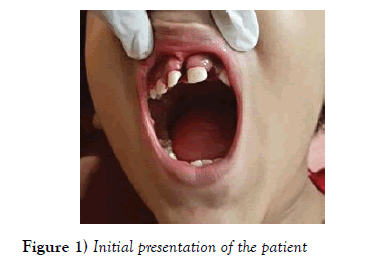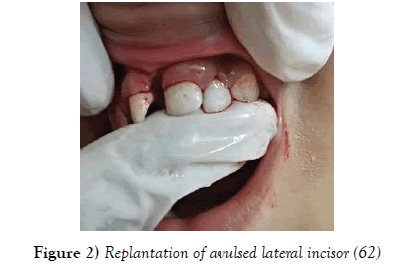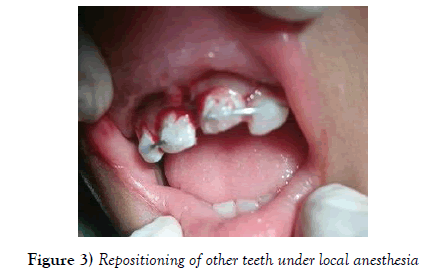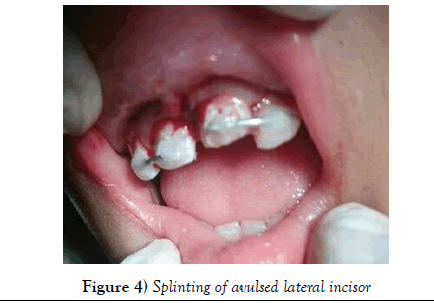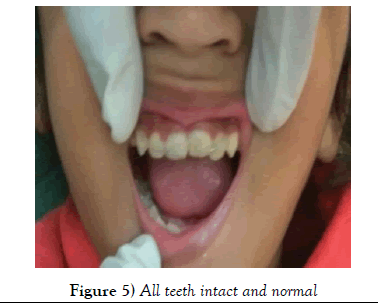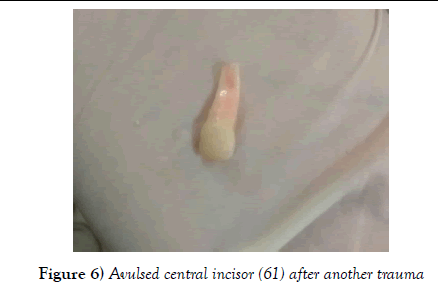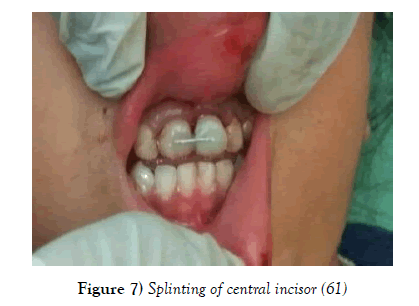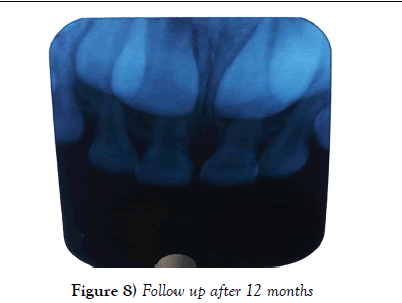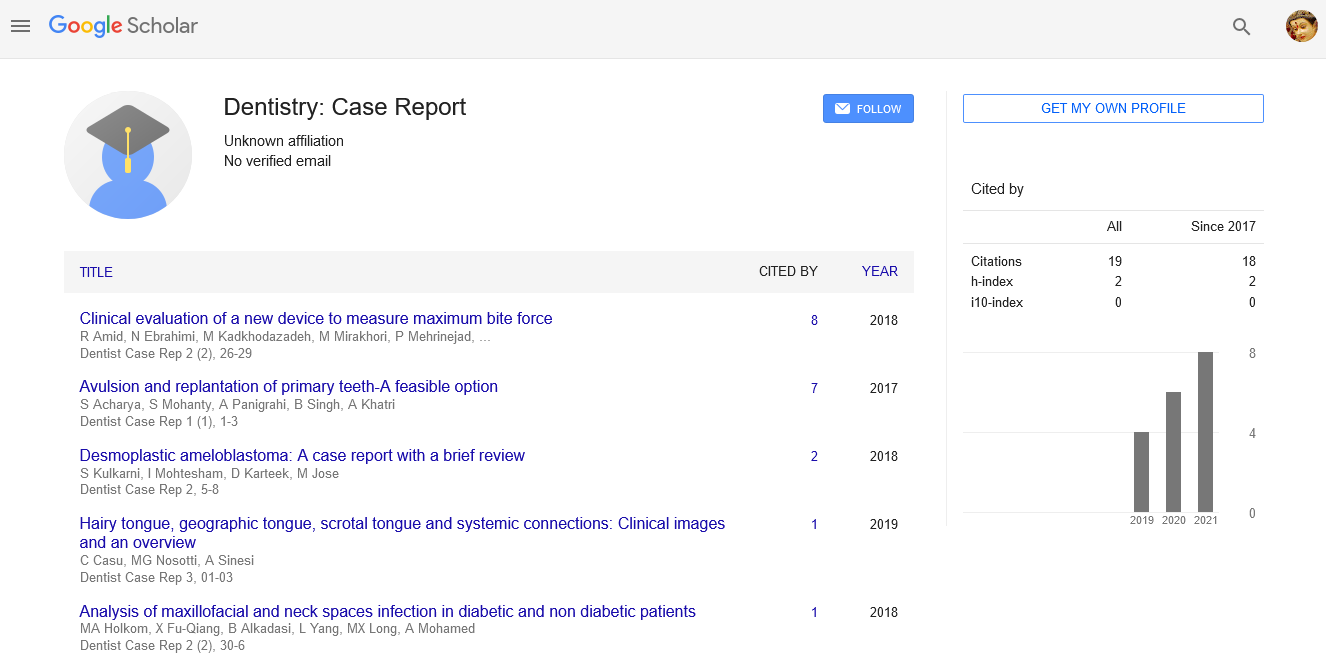Avulsion and replantation of primary teeth - A feasible option
2 Department of Pedodontics and Preventive Dentistry, UCMS and GTB Hospital, New Delhi, India, Email: dentist123@gmail.com
Received: 21-Aug-2017 Accepted Date: Sep 13, 2017; Published: 15-Sep-2017
Citation: Acharya S, Mohanty S, Panigrahi A, et al. Avulsion and replantation of primary teeth - A feasible option. Dentist Case Rep 2017;1(1):1-3.
This open-access article is distributed under the terms of the Creative Commons Attribution Non-Commercial License (CC BY-NC) (http://creativecommons.org/licenses/by-nc/4.0/), which permits reuse, distribution and reproduction of the article, provided that the original work is properly cited and the reuse is restricted to noncommercial purposes. For commercial reuse, contact reprints@pulsus.com
Abstract
Pediatric dentists who treat a significant number of children under 4 years of age are likely to encounter a child with an avulsed primary tooth especially the incisors routinely in their practice. The question of whether to replant these teeth has been a focus of debate and controversy in the dental literature. The authors who have tried to replant the primary incisory have faced lot of criticism from their peers. Although there is a dearth of studies regarding the replantation of these teeth but individual case reports have stated that replantation can be tried in primary teeth. Here we discuss the management of avulsed primary teeth and its follow up in a three year old female child who had a trauma twice in the same region of face but lost two different teeth in different incidences.
Keywords
Avulsion; Facial; Primary incisors; Replantation trauma
Facial trauma in children can result in fractured, displaced and avulsed teeth which can have a negative effect on child’s appearance, psychology and function [1]. The greatest incidence of trauma to the primary teeth occurs at 2 to 3 years of age, when motor coordination is developing [2]. The most common injuries to primary teeth occur secondary to falls, followed by accidents, violence, and sports [3]. Dental injuries may have improved outcomes if the public were made aware of first-aid measures and the need to seek immediate treatment. Optimal treatment results can be obtained with immediate assessment and care [4]. Avulsion of primary teeth has been reported to comprise between 5.8% and 19.4% of all types of traumatic injuries to the primary dentition and 19.2% of luxation injuries only [5]. It occurs more frequently in boys than in girls. The maxillary primary central incisor is involved more than any other tooth, followed by maxillary lateral incisors and mandibular central incisors [6]. Reports of avulsion of canines and molars are there but extremely rare in primary dentition [7,8]. Avulsion of a primary incisor is often associated with luxation injuries to adjacent teeth, fracture of the facial bone and laceration of the surrounding gingiva and lips [9]. The options available for treatment in avulsion are a) no treatment, b) replacement of tooth and c) replantation of the avulsed tooth [10,11]. All relevant diagnostic information, treatment and recommended follow up care should be discussed with parents and mentioned in the patient’s record. Publications regarding replantation and its outcome of avulsed permanent teeth are abundant but the studies on the same in primary incisors teeth are scant and superficial. Here we discuss an unusual case of a three year old female child who had trauma to her incisors and had avulsion twice of two different tooth, maxillary lateral incisor in the first trauma and central incisor in the next trauma, both trauma in a space of three weeks.
Case Report
Three years old female child visited to the clinic with complain of fall while climbing a grilled door. The child had an avulsed lateral incisor of left side 62 due to the trauma and gingival laceration in between central incisors with luxation and displacement of right lateral incisor, central incisor and fractured alveolar bone (Figure 1).
The child also had associated lip lacerations. The parents were knowledgeable about avulsed tooth management and so had not cleaned the tooth rigorously and also they were aware of the transport materials to be used. The avulsed lateral incisor was bought to the clinic by the parents kept in a container with milk. The child was bought to the clinic within 10 minutes of trauma as they stayed near to the clinic. The parents wanted the avulsed tooth to be put back into the socket as they thought the appearance of the child will not be good without that tooth. The tooth was decided to be replanted as the child was young and the parents insisted (Figure 2).
The first objective of treatment was to manage the bleeding, which was done by debridement of the area and irrigation with normal saline and cold compression with ice packs. The debridement of socket was also done to remove the clot which may cause problem in replantation procedure. The displaced teeth 525161 were repositioned with gentle but firm pressure after administration of local anesthesia (Figure 3).
The tooth 62 was replanted in place and splinted with soft stainless-steel wire and light cure resin (Figure 4).
The patient was advised soft diet for seven days and antibiotics and analgesics were prescribed for the same time. The splinting was done for fourteen days and removed. All the teeth 52516162 were stable with no abnormal mobility (Figure 5).
The parents and the child were happy. The patient was kept on follow up. Unfortunately for the child, parents and us the child had a fall from cycle the next day and this time 61 was avulsed. The parents got the tooth after gentle cleaning immediately in a container of milk (Figure 6).
Despite our telling that this time the prognosis might not be good and we can go for replacement of the tooth they urged us to replant the tooth as this was the front tooth. The tooth was replanted and splinted with soft stainless steel wire and resin (Figure 7).
The patient was advised soft diet for seven days along with antibiotics and analgesics. The patient was kept under follow up for the past 12 months and no signs of mobility or radiographic changes are seen (Figure 8).
The follow up in our case was unfortunately not possible for a longer period as the parents shifted to other place (Other state).
Discussion
Avulsions of primary teeth range from 7-13 percent of all injuries in primary dentition but data related to this is few [12]. The maxillary central incisors are the most commonly avulsed teeth due to their slight buccal apical inclination and forces directed to the palatal surface [13]. Tooth avulsions occur in very young children when they learn to walk and run. Other causes are play, fight and child abuse [14]. A recent guideline for treatment of traumatic dental injuries in primary dentition does not recommend replantation of primary teeth but then pediatric dentists are often faced with the dilemma of replantation of avulsed primary teeth especially incisors when parents urge them to save the tooth [15]. Replantation of primary incisors has been carried out in some studies and reported for some individuals where the criteria adopted appear to be based on the protocol relating to replantation of permanent incisors [16]. The outcome is based largely on the descriptions and opinions contained in the sporadic case reports rather than any scientific evaluation. The evaluation depends on teeth involved, age of the child, alveolar damage, extra-oral period, use of splint, radiographic examination, follow-up intervals [17,18].
There are very few systematic reviews which support the replantation of primary incisors [19]. The argument that have been given against replantation are children do not have esthetic demands, costs, time consumption, behavioral problems, risk to permanent incisors, pulp necrosis, resorption [20]. Then the child is also subjected to additional procedures of splinting, radiographs, local anesthetic agent’s use. The benefits associated are maintenance of normal dentition, protection of self-esteem and social acceptance, prevention of articulation problems, space maintenance [21]. The main idea behind replantation of primary incisors is to return the child to normalcy which will improve the patient self-esteem. Parents also have the feeling of guilt which is why they urge the pediatric dentist to replant the tooth. Some authors have suggested that failing to replant incisors may lead to problems in speech, mastication and development of habits [22]. The replantation of primary incisors may be feasible and effective if performed under optimal conditions [23]. The root development stage is first aspect to consider. If the tooth exhibits any sign of resorption, pediatric dentists should not consider replantation as such teeth have no strategic value. In our case there was no root resorption as the child was young (3 years). The extra oral time is stated to be less than 30 minutes for a fruitful replantation because of the viability of periodontal ligament [24]. The patient in our case was brought to our clinic within 10 minutes. The storage medium plays an important role for maintain the viability of cells on the root. Hanks buffered salt solution, milk, child’s own saliva or blood are ideal and in the case reported the parents got the tooth in milk [25]. The next recommendation is for the cleanliness of the tooth and the replantation area as a clean injury has better prognosis than contaminated injury [26]. Avulsion can cause disruption of vascular nerve bundle with loss of blood supply to tooth leading to necrosis. Thus it has been recommended that endodontic treatment should be done [27]. In two cases reported, the endodontic treatment was not performed in replanted teeth [3]. It is possible that primary young teeth with wide open apical foramen may undergo revascularization, although no data is there. In this case also we did not do any endodontic intervention. The splinting of teeth was reported in many cases and has to be semi-rigid to allow physiological tooth movement, allowing the reattachment of periodontal ligament [28]. We also performed a semi rigid splinting with soft stainless steel wire for 21 days. The last but not the least important factor is following up. Follow up should be as long as possible to see that the replantation is deemed a success. Here we would like to add that peer-reviewed dental literature describes the outcomes for replanted primary incisors consisting entirely of isolated case reports. These reports provide limited and often incomplete information on the teeth involved, the extent of radiographic examinations, splint usage, extraalveolar time of the avulsed tooth, and follow-up protocols. Consequently, all of the evidence for replantation is level III (non-experimental, descriptive and opinion [29]. The most useful case studies were those of Kinoshita and others, Weiger and Heuchert and Pefaur [3,9,25]. The largest number of replanted primary incisors and most complete description of the outcome is in the report of individual cases by Kinoshita and others [3]. They describe long-term (>1 year) outcomes for 8 replanted incisors (maxillary and mandibular). These incisors were all splinted following replantation. Dental pulps were left in all but one incisor despite ischemic periods in excess of 30 minutes. Four incisors were subsequently extracted due to abscess or pathological root resorption, three exfoliated physiologically and one was retained. One permanent incisor had an enamel defect. Since there are no published guidelines for the management of avulsed primary incisors, there was no consistency in the management techniques described in the cited papers [30]. The main limitation in our case was the follow up which again is due the patient compliance and negligence. Still follow up of 12 months is beneficial for the purpose of esthetics and to maintain self-esteem in our young patient. The highlight of our study is the multiple trauma to the same region but avulsion occurring in two different teeth, i.e., first in central incisor, next in lateral incisor showing that lateral incisor could tolerate the trauma the second time. The replantation was done in our case as per parents demand even after being told about the risks associated with primary tooth replantation. The child and parents were in shock to see parents that replantation is not riskless.
Conclusion
The relevant studies related to replantation of primary teeth are scanty and most authors recommend not to replant an avulsed primary tooth. There is a lack of quality studies with good sample size and long follow up periods. Although the typical mindset of many pediatric dentists is not to replant primary teeth but still evaluating the risks and benefits of the replantation procedure will allow us to take steps which will be beneficial to the parents and the child.
REFERENCES
- Borum MK, Andreasen JO. Sequelae of trauma to primary maxillary incisors. I. Complications in the primary dentition. Endod Dent Traumatol 1998;14(1):31-44.
- Onetto JE, Flores MT, Garbarino ML. Dental trauma in children and adolescents in Valparaiso, Chile. Endod Dent Traumatol 1994; 10(5):223-7.
- Kinoshita S, Mitomi T, Taguchi Y, et al. Prognosis of replanted primary incisors after injuries. Endod Dent Traumatol 2000; 16(4):175-83.
- Tsukiboshi M. Trauma to the primary dentition. In: Tsukiboshi M, (ed). Treatment planning for traumatized teeth. Carol steam: Quintessence Publishing, USA. 2000:105-16.
- Kenwood M, Seow WK. Sequelae of trauma to the primary dentition. J Pedod 1989;13:230-8.
- Ravn JJ. Sequelae of acute mechanical traumata in the primary dentition. ASDC J Dent Child 1968;35:281-9.
- Steelman R, Holmes D, Byron M, et al. Traumatic avulsion of the mandibular right lateral incisor and cuspid. J Clin Pediatr Dent 1991;15:24-50.
- Mentz DD, Rollefson JH. Avulsion of a maxillary primary first molar in a 19-month old child. Pediatr Dent 1993;15:47.
- Weiger R, Heuchert T. Management of an avulsed primary incisor. Endod Dent Tramatol 1999;15:138-43.
- Waggoner WF, Kupietzky A. Anterior esthetic fixed appliances for the preschooler: Considerations and a technique for placement. Pediatr Dent 2001;23:147-50.
- Crabb JJ, Crabb VP. Re-implantation of a primary central incisor: A case report. Dent Pract Dent Rec 1971;21:353-4.
- Andreasen JO, Andreasen FM, Bakland LK, et al. Injuries to the primary dentition. In: Andreasen JO, Andreasen FM, Bakland LK, Flores MT, (ed). Traumatic dental injuries — A manual. Copenhagen: Munksgaard 1999;44-7.
- Mackie IC, Warren VN. Dental trauma: General aspects of management and trauma to the primary dentition. Dent Update 1988;15:155-9.
- Cunha CBCS, Rodrigues FG, Primo LG. Clinical approach regarding a re-implanted primary tooth. JBP Rev Ibero-Amodontopediatr Odontol Bebe 2004;7:426-9.
- Malmgren B, Andreasen JO, Flores MT, et al. International Association of Dental Traumatology guidelines for the management of traumatic dental injuries: Injuries to the primary dentition. Dent Traumatol 2012;28:174-82.
- Christophersen P, Freund M, Harild L. Avulsion of primary teeth and sequelae on the permanent successors. Dent Traumatol 2005;21:320-3.
- Filippi A, Pohl Y, Kirchner H. Replantation of avulsed primary anterior teeth: Treatment and limitations ASDC J Dent Child 1997;64:272-5.
- Eisenberg MD. Reimplantation of a deciduous tooth. Oral Surg Oral Med Oral Pathol 1965; 19(5):588-90.
- Martins-Júnior PA, Franco FA, De Barcelos RV, et al. Replantation of avulsed primary teeth: A systematic review. Int J Paediatr Dent. 2014 Mar;24(2):77-83.
- Gatewood JC, Thornton JB. Successful replantation and splinting of a maxillary segment fracture in the primary dentition. Pediart Dent 1995;17:124-6.
- Judd PL, Casas MJ. Psychosocial perceptions of premature tooth loss in children. Ont Dent 1995 72(8):16-8,20,22-3.
- Gable TO, Kummer AW, Lee L, et al. Premature loss of the maxillary primary incisors: Effect on speech production. ASDC J Dent Child 1995; 62(3):173-9.
- Friedlander LT, Chandler NP, Drummond BK. Avulsion and replantation of a primary incisor tooth. Dent Traumatol. 2013 Dec;29(6):494-7.
- Kawashima Z, Pineda FR. Replanting avulsed primary teeth. J Am Dent Assoc 1992;123(90-91):94.
- Pefaur A. Reimplantation of a deciduous tooth after traumatic avulsion. Rev Fac Odontol University, Chile. 1988;6:20-4.
- De Carvalho Rocha MJ, Cardoso M. Replantation of primary tooth-case report. Dent Traumatol 2008;30:e4-e10.
- Al-Khayatt AS, Davidson LE. Complications following replantation of a primary incisor: A cautionary tale. Br Dent J. 2005 Jun 11;198(11):687-8.
- Bassiouny MA, Giannini P, Deem L. Permanent incisors traumatized through predecessors: Sequelae and possible management. J Clin Pediatr Dent 2003;27:223-8.
- Canadian Task Force on the Periodic Health Examination. The periodic health examination. Can Med Assoc J 1979; 121(9):1193-254.
- Zamon EL, Kenny DJ. Replantation of avulsed primary incisors-A risk benefits assessment. J Can Dent Assoc 2001; 67:386.



